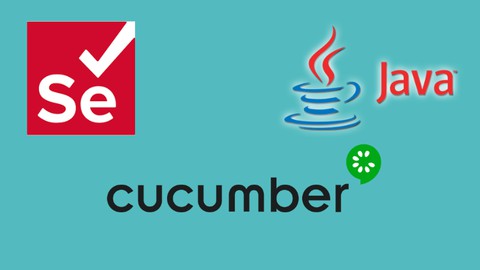
Learn Selenium with Java, Cucumber & Frameworks
Learn Selenium with Java, Cucumber & Frameworks, available at $129.99, has an average rating of 4.6, with 72 lectures, based on 8181 reviews, and has 39946 subscribers.
You will learn about You will learn how to write test scripts using Selenium WebDriver. You will know how to identify identify various web elements using Selenium. You will know how to work with Selenium Grid. You will know how to design frameworks from scratch. You will able to work on Real time projects after you completed this course. You will know about Continuous Integration(CI) Process and Tools. This course is ideal for individuals who are Any Fresh Graduates, Students, Working professionals, Manual testers & who wish to learn this course in order to transform as an Automation Test Engineer can go for this course. It is particularly useful for Any Fresh Graduates, Students, Working professionals, Manual testers & who wish to learn this course in order to transform as an Automation Test Engineer can go for this course.
Enroll now: Learn Selenium with Java, Cucumber & Frameworks
Summary
Title: Learn Selenium with Java, Cucumber & Frameworks
Price: $129.99
Average Rating: 4.6
Number of Lectures: 72
Number of Published Lectures: 72
Number of Curriculum Items: 72
Number of Published Curriculum Objects: 72
Original Price: ₹7,900
Quality Status: approved
Status: Live
What You Will Learn
- You will learn how to write test scripts using Selenium WebDriver.
- You will know how to identify identify various web elements using Selenium.
- You will know how to work with Selenium Grid.
- You will know how to design frameworks from scratch.
- You will able to work on Real time projects after you completed this course.
- You will know about Continuous Integration(CI) Process and Tools.
Who Should Attend
- Any Fresh Graduates, Students, Working professionals, Manual testers & who wish to learn this course in order to transform as an Automation Test Engineer can go for this course.
Target Audiences
- Any Fresh Graduates, Students, Working professionals, Manual testers & who wish to learn this course in order to transform as an Automation Test Engineer can go for this course.
Selenium, an open-source automation testing tool designed for web applications, operates seamlessly on various web browsers like Firefox, Chrome, Edge, Opera, Safari, and supports multiple platforms such as Windows, Linux, and Macintosh. This comprehensive Selenium course caters to a wide range of proficiency levels, from basic to expert, covering diverse ways of interacting with web pages through Selenium. The course incorporates real-life examples from live websites to illustrate each topic.
Throughout the course, participants will delve into best practices associated with Selenium WebDriver, including the utilization of tools such as TestNG, Maven, and popular frameworks like the Page Object Model. Regular updates will be provided to accommodate new features/APIs in Selenium WebDriver, ensuring participants stay current with industry trends.
The course is structured around several modules, covering essential topics such as:
Module-1: Overview on Automation & Selenium
-
Introduction to Automation
-
Challenges in Manual Testing
-
Overcoming Challenges with Automation
-
Importance of Programming in Automation
-
Introduction to Selenium
-
Selenium Components
-
Advantages and Disadvantages of Selenium WebDriver
Module-2: Java Programming for Selenium
-
Java and Eclipse Environment Setup
-
Setting up Java Development Kit (JDK)
-
Installing Eclipse IDE
-
Configuring Java and Eclipse Environment
-
-
How to Write Basic Java Program?
-
Creating a Java Class
-
Main Method in Java
-
Writing the First Java Program
-
Compiling and Running Java Programs
-
-
Understanding Console Output
-
Using System.out.println() for Output
-
Printing Variables and Text to Console
-
-
Java Variables and Data Types
-
Declaring Variables in Java
-
Primitive Data Types (int, float, double, char, boolean)
-
Variable Naming Conventions
-
-
Java Operators
-
Arithmetic Operators
-
Relational Operators
-
Logical Operators
-
Assignment Operators
-
Increment and Decrement Operators
-
Ternary Operators
-
-
Conditional Statements
-
If Statement
-
If-Else Statement
-
Switch-Case Statement
-
-
Loops
-
While Loop
-
Do-While Loop
-
For Loop
-
-
Jumping Statements
-
Using break Statement
-
Using continue Statement
-
-
Arrays – Single & Two Dimensional
-
Declaring and Initializing Arrays
-
Accessing Array Elements
-
Single-Dimensional Arrays
-
Two-Dimensional Arrays
-
Object Type Array
-
Coding Exercises on Arrays
-
-
String Class
-
Introduction to the String Class
-
Creating Strings
-
String Concatenation
-
String Length
-
String Comparison
-
-
String Methods
-
Common String Methods
-
Coding Exercises on Strings
-
Module 3: Java OOPS Concepts
-
Classes and Objects
-
Introduction to Classes and Objects
-
Creating Classes
-
Declaring Object Instances
-
Class Members: Fields and Methods
-
-
Java Methods & Constructors
-
Defining Methods
-
Method Signatures
-
Return Types
-
-
Passing Parameters to Methods
-
Passing Parameters
-
Call by Value
-
Call by Reference (Reference Passing)
-
-
Java Constructor
-
Constructor Basics
-
Parameterized Constructors
-
Default Constructors
-
-
Polymorphism
-
Introduction to Polymorphism
-
-
Overloading Methods
-
Method Overloading
-
Overloading with Different Parameter Types
-
Overloading with Different Number of Parameters
-
-
Overloading Constructors
-
Constructor Overloading
-
Creating Constructors with Different Parameters
-
-
Encapsulation
-
Encapsulation Overview
-
-
Setters and Getters
-
Purpose of Setters and Getters
-
Encapsulation with Setters and Getters
-
-
this Keyword
-
Understanding the this Keyword
-
Using this to Differentiate Instance and Local Variables
-
-
Static Variables and Methods
-
Static Variables
-
Static Methods
-
Accessing Static Members
-
-
Inheritance
-
Basics of Inheritance
-
Extending Classes
-
Superclass and Subclass
-
-
Types of Inheritance
-
Single Inheritance
-
Multiple Inheritance
-
Multilevel Inheritance
-
Hierarchical Inheritance
-
-
Method Overriding
-
Overriding Methods in Subclasses
-
Use of @Override Annotation
-
-
super Keyword
-
Using super to Access Superclass Members
-
Invoking Superclass Methods
-
-
final Keyword
-
Final Variables
-
Final Methods
-
Final Classes
-
-
Abstract Class
-
Abstract Class Overview
-
Abstract Methods
-
Creating Abstract Classes
-
-
Java Interface
-
Introduction to Interfaces
-
Implementing Interfaces
-
Multiple Interface Implementation
-
-
Java Packages
-
Organizing Code with Packages
-
Creating and Using Packages
-
-
Access Modifiers
-
Public, Private, Protected, Default Access Modifiers
-
Access Modifier Scope
-
-
Wrapper Classes
-
Primitive Data Types vs Wrapper Classes
-
Autoboxing and Unboxing
-
-
Data Conversion Functions
-
Converting Data Types
-
Casting – Up Casting and Down casting
-
-
Reading Input from Keyboard
-
Using Scanner Class for Input
-
-
Exception Handling
-
Introduction to Exception Handling
-
Try, Catch, Finally Blocks
-
Types of Exceptions
-
-
Java Collections
-
Overview of Java Collections Framework
-
Lists, Sets, Maps
-
Iterators
-
Collections Methods
-
Module-4: Selenium WebDriver (Latest Version)
-
Introduction to WebDriver and Architecture
-
Overview of Selenium WebDriver
-
Architecture of Selenium WebDriver
-
-
Environment Setup & WebDriver Configuration
-
Setting up WebDriver in Eclipse
-
Configuring WebDriver for Different Browsers
-
-
How to Create Automated Test Case in WebDriver?
-
Setting Up a Basic Test Case Structure
-
Writing and Running Simple WebDriver Test Cases
-
-
Execute Test Case on Multiple Browsers
-
Cross-Browser Testing
-
Running Tests on Different Browsers
-
-
Understanding HTML Tags and Attributes
-
HTML Basics for Selenium Testers
-
Locating Elements Using HTML Tags and Attributes
-
-
Basic Locators
-
Name Locator
-
ID Locator
-
LinkText Locator
-
PartialLinkText Locator
-
-
Advanced Locators
-
CSS Locators
-
XPath Locators
-
XPath Axes
-
-
Relative Locators
-
.above, .below, .toLeftOf, .toRightOf, .near
-
-
How to Use SelectorsHub & Features of Selectors Hub
-
Overview of SelectorsHub
-
Features and Benefits
-
-
WebDriver Methods
-
Opening Page URL
-
Verifying Page Title
-
Getting Page Source
-
Getting Page URL
-
Conditional Methods
-
Visibility of WebElements
-
Enable/Disable Status of Web Elements
-
-
-
Waits
-
Implicit Waits
-
Explicit Waits
-
Fluent Waits
-
Page Load Time
-
-
Navigation Methods
-
Navigating Back & Forward
-
Refreshing Page
-
-
Browser Commands
-
close() and quit()
-
getWindowHandle() and getWindowHandles()
-
-
Working with Web Elements
-
Handling Input Boxes
-
Handling Checkboxes & Radio Buttons
-
Handling Links
-
-
Handling Alerts/Popups
-
Handling Alert Boxes
-
Handling Confirmation Boxes
-
Handling Prompt Boxes
-
-
Handling Iframes & Inner Iframes
-
Switching to Iframes
-
Working with Nested Iframes
-
-
Handling Drop Downs
-
Select type Drop down
-
Bootstrap Drop Downs
-
Multi Select Drop Down
-
Auto Suggest Drop Down
-
-
Working with Browser Windows
-
Switching Between Browser Windows
-
Handling Tabs and Windows
-
-
Handling Static & Dynamic Web Tables
-
Strategies for Handling Tables
-
Handling Static Tables
-
Handling Dynamic Tables
-
Pagination Tables
-
-
Handling Date Pickers
-
Strategies for Handling Date Pickers
-
-
Handling Mouse Actions
-
Using Actions Class
-
Right Click, Double Click, Mouse Over
-
Drag and Drop Actions
-
-
Handling Keyboard Actions and Shortcuts
-
Using Actions Class for Keyboard Actions
-
-
Working with JavascriptExecutor
-
Executing JavaScript Code in Selenium
-
-
Scrolling Web Page
-
Scrolling Up and Down the Page
-
-
Zoom In & Zoom Out, Maximize, Minimize Web Page
-
Managing Browser Window Size
-
-
Opening Links in New Tab
-
Handling New Tabs
-
-
Working with Tabs and Windows
-
Switching Between Tabs and Windows
-
-
Capturing Screenshots
-
Taking Screenshots in Selenium
-
-
Working with Cookies
-
Managing Cookies in Selenium
-
-
Headless Browser Testing
-
Overview of Headless Testing
-
Advantages and Disadvantages
-
-
SSL Certificate Handling
-
Handling SSL Certificates
-
-
Browser Settings with ChromeOptions
-
Customizing Chrome Browser Settings
-
-
Enable Extensions on Browser at Runtime
-
Managing Browser Extensions
-
-
Blocking Ads on WebPage at Runtime
-
Blocking Ads Using WebDriver
-
-
Run Tests in Incognito Mode
-
Running Tests in Incognito/Private Mode
-
-
How to Handle Upload Files (Single and Multiple)
-
Uploading Files in Selenium
-
-
Handling Broken Links
-
What is Broken link?
-
How to find Broken links in web page
-
-
Handling shadowDOM, SVG Elements
-
Strategies for Handling shadowDOM and SVG Elements
-
-
Selenium WebDriver Exceptions
-
Working with Excel Files Using Apache POI API
-
Reading and Writing Excel Files
-
-
Data-Driven Testing
-
Strategies for Data-Driven Testing
-
Implementing Data-Driven Tests in Selenium
-
-
Reading Properties File
Module-5: TestNG
-
Introduction to TestNG and Advantages
-
Overview of TestNG
-
Advantages of TestNG over JUnit
-
TestNG Features
-
-
Configuring TestNG in Project
-
Setting up TestNG in Eclipse or IntelliJ
-
Configuring TestNG Dependencies in the Project
-
-
Writing TestNG Test Cases
-
Basics of Writing TestNG Test Cases
-
Annotations in TestNG
-
-
Prioritizing Tests
-
Setting Test Case Priority
-
Running Tests in Priority Order
-
-
Understanding Testng.xml
-
Structure of TestNG XML File
-
Configuring Test Suites and Test Cases
-
-
TestNG Report
-
TestNG HTML Reports
-
Viewing and Analyzing TestNG Reports
-
-
TestNG Annotations
-
@BeforeSuite, @AfterSuite
-
@BeforeTest, @AfterTest
-
@BeforeClass, @AfterClass
-
@BeforeMethod, @AfterMethod
-
@Test Annotation
-
-
Types of Assertions (Hard and Soft Assertions)
-
Using Hard Assertions in TestNG
-
Using Soft Assertions in TestNG
-
-
dependsOnMethods
-
Defining Dependencies Between Test Methods
-
Ensuring Test Methods Run in a Specific Order
-
-
Skipping and Ignoring Tests
-
Skipping Tests in TestNG
-
Ignoring Tests in TestNG
-
-
Grouping Tests
-
Grouping Tests in TestNG
-
Running Tests by Groups
-
-
Parameterizing Tests (XML File, DataProviders)
-
Parameterizing Tests Using TestNG XML File
-
Parameterizing Tests Using DataProviders
-
-
@DataProvider
-
Understanding @DataProvider Annotation
-
Providing Test Data to Test Methods
-
-
Invocation Count
-
Repeating Test Execution with Invocation Count
-
-
Parallel Testing
-
Running Tests in Parallel
-
Configuring Parallel Execution in TestNG
-
-
TestNG Listeners
-
Overview of TestNG Listeners
-
Implementing Listeners in TestNG
-
Types of TestNG Listeners (e.g., ITestListener, IAnnotationTransformer)
-
Module-6: Extent Reports, Log4j2 & Page Object Model Pattern
-
Generating Extent Reports
-
Log4j2 for Logging
-
Page Object Model (POM) Pattern
-
Creating Page Object Classes without Page Factory
-
Creating Page Object Classes using Page Factory
-
@FindBy annotation
Module-7: Selenium Grid
-
Introduction to Selenium Grid
-
Setting Up Grid Environment (Stand Alone, Hub with Nodes)
-
Running Selenium Tests on Grid
Module-8: Docker
-
What is Docker
-
What is Docker Image
-
What is Docker Container
-
How to create account on Docker Hub
-
Download Images from Docker Hub
-
Docker UI Application
-
Selenium Grid Configuration on Docker Hub
-
Run your test cases on Dockerized Selenium Grid
-
Setup Infrastructure using Docker Compose yml
-
Scale up the browsers at the run time
-
Shut down the Docker Infrastructure
Module-9: Introduction to Automation Frameworks
-
Introduction to Automation Frameworks
-
Types of Frameworks
-
Phases in Designing Framework
-
Choosing Test Cases for Automation
Module-10: Hybrid Framework with POM (Page Object Model) – Project
-
Creating Maven Project and update pom.xml with dependencies
-
Creating Folder Structure
-
Creating Page Objects and Object Repository
-
Creating Utility files
-
Generating Extent Reports
-
Generating Logs using Log4j2
-
Setting Up Configuration Files
-
Creating Automation Test Cases
-
Creating Data-Driven Test Cases
-
Creating Database Test Cases
-
Executing Test Scripts using TestNG XML File
-
Emailing Test Reports
-
Executing Test Scripts through Command Line
-
Executing Test Scripts using Batch File
-
Executing Test Scripts on Selenium Grid
-
Executing Script on Docker Container
Module-11: Cucumber BDD Framework
-
Introduction to BDD and Cucumber
-
Gherkin Language Keywords
-
Feature Files
-
Step Definitions
-
TestRunner Class
-
Data Tables and Scenario Outline
-
Tags, Background
-
Cucumber Hooks
-
Cucumber Reports
-
Cucumber Extent Reports
Module-12: CI & CD Concepts( Git, Github & Jenkins)
-
Version Control System Overview
-
Git and GitHub
-
Git Commands
-
Continuous Integration (CI) and Continuous Delivery (CD)
-
Jenkins Overview
-
Maven Integration with Jenkins
-
Running Selenium Tests through Jenkins
Module-13: How to use ChatGPT in Automation
-
What is AI, ChatGPT & Google Gemini
-
What is Prompting?
-
How to Create prompts?
-
Frequently used Prompts in Software Testing
-
How to use use ChatGPT in Automation
Module-14: Resume Preparation and Guidance
-
Guidance in Resume Preparation
Course Curriculum
Chapter 1: Overview on Software Testing & Automation
Lecture 1: Introduction on Automation & Selenium
Chapter 2: Java Programming
Lecture 1: Environment Setup for Java & Eclipse
Lecture 2: Variables & Data Types in Java
Lecture 3: Java Operators
Lecture 4: Java Conditional Statements
Lecture 5: Java Loops
Lecture 6: Java Arrays (Part 1)
Lecture 7: Java Arrays (Part-2)
Lecture 8: Working with Strings in Java (Part-1)
Lecture 9: Working with Strings in Java (Part-2)
Lecture 10: Java OOPS Concepts, Class, Object, Methods
Lecture 11: Java Methods and Constructors
Lecture 12: Polymorphism – Method Overloading and Constructor Overloading
Lecture 13: Encapsulation, Setters & getters, static keyword
Lecture 14: Inheritance, Types of Inheritance
Lecture 15: Method Overriding, super keyword, final keyword
Lecture 16: Data Abstraction – Interface and Abstract Class
Lecture 17: Data Conversion, Wrapper Classes & Java Packages
Lecture 18: Type casting concept – Up casting & Down casting
Lecture 19: Exception Handling in Java
Lecture 20: Java Collections
Chapter 3: Selenium WebDriver
Lecture 1: Introduction to WebDriver & Setting up WebDriver Environment
Lecture 2: Selenium Locators – ID, Name, LinkText, Partial LinkText, TagName
Lecture 3: Selenium Locators – CSS Selector
Lecture 4: Selenium Locators – XPath
Lecture 5: Selenium Locators – XPath Axes
Lecture 6: WebDriver Methods – Get methods, Conditional methods & Browser methods
Lecture 7: WebDriver Methods – Different types of Waits
Lecture 8: WebDriver Methods – Browser Methods and Navigation methods
Lecture 9: Handle Checkboxes & Radio Buttons
Lecture 10: Handle Different Types of Alerts & Frames
Lecture 11: Handle Different types of drop downs
Lecture 12: Handle Static Web Table
Lecture 13: Handle Dynamic & Pagination Web Table
Lecture 14: Handle Date Pickers
Lecture 15: Handle Mouse Events
Lecture 16: Handle Keyboard Events, Tabs & Windows
Lecture 17: Handle File Upload,Scrolling Page, JavascriptExecutor
Lecture 18: Capture screenshots, HandleSSL,Headless browser, Blocking Ads,ChromeExtensions
Lecture 19: Handle Broken Links, Handle SVG Elements & Shadow DOM Elements
Chapter 4: Apache POI – Data Driven Testing using MS Excel
Lecture 1: Reading Excel & Writing Data into Excel
Lecture 2: Data Driven Testing using Microsoft Excel
Chapter 5: TestNG Framework for Selenium
Lecture 1: Introduction to TestNG
Lecture 2: TestNG Annotations & Types of Assertions
Lecture 3: Dependency Methods & Grouping
Lecture 4: Data Providers and Parallel Testing
Lecture 5: TestNG Listeners & Extent Reports
Chapter 6: Page Object Model
Lecture 1: Page Object Model Pattern – Page Factory
Chapter 7: Hybrid Driven Framework Development with Project (eCommerce Application)
Lecture 1: Automation Framework -Session1
Lecture 2: Automation Framework -Session2
Lecture 3: Automation Framework -Session3
Lecture 4: Automation Framework -Session4
Lecture 5: Automation Framework -Session5
Lecture 6: Automation Framework -Session6 (Run Tests on Selenium Grid)
Lecture 7: Automation Framework -Session7( Docker Integration with Selenium Grid)
Chapter 8: CI – Maven, Git, Github & Jenkins
Lecture 1: Continuous Integration Part -1
Lecture 2: Continuous Integration Part -2
Chapter 9: Cucumber BDD Framework
Lecture 1: Cucumber and BDD Concepts
Lecture 2: Cucumber Framework -Part1
Lecture 3: Cucumber Framework – Part2
Chapter 10: Bonus topics
Lecture 1: Git Options in Eclipse & IntelliJ IDE
Lecture 2: How to use ChatGPT in Software testing and automation
Chapter 11: SelectorsHub
Lecture 1: SelectorsHub
Chapter 12: Wind up Session- Learning , Practice Plan & Interview Preparation Tips
Lecture 1: Interview Preparation
Chapter 13: Docker – Bonus Topics
Lecture 1: Docker Introduction
Lecture 2: Docker Installation
Lecture 3: Docker Terminology
Lecture 4: Docker Commands
Lecture 5: How To Run Selenium Tests on Docker Containers
Lecture 6: Selenium Grid Setup with Docker
Lecture 7: How to Invoke Docker Grid using bat files
Lecture 8: Docker with Selenium Grid Integration with Jenkins
Instructors
-
Pavan Kumar
Tech Educator | Trainer | YouTuber
Rating Distribution
- 1 stars: 56 votes
- 2 stars: 64 votes
- 3 stars: 485 votes
- 4 stars: 2859 votes
- 5 stars: 4717 votes
Frequently Asked Questions
How long do I have access to the course materials?
You can view and review the lecture materials indefinitely, like an on-demand channel.
Can I take my courses with me wherever I go?
Definitely! If you have an internet connection, courses on Udemy are available on any device at any time. If you don’t have an internet connection, some instructors also let their students download course lectures. That’s up to the instructor though, so make sure you get on their good side!
You may also like
- Best Cybersecurity Fundamentals Courses to Learn in March 2025
- Best Smart Home Technology Courses to Learn in March 2025
- Best Holistic Health Courses to Learn in March 2025
- Best Nutrition And Diet Planning Courses to Learn in March 2025
- Best Yoga Instruction Courses to Learn in March 2025
- Best Stress Management Courses to Learn in March 2025
- Best Mindfulness Meditation Courses to Learn in March 2025
- Best Life Coaching Courses to Learn in March 2025
- Best Career Development Courses to Learn in March 2025
- Best Relationship Building Courses to Learn in March 2025
- Best Parenting Skills Courses to Learn in March 2025
- Best Home Improvement Courses to Learn in March 2025
- Best Gardening Courses to Learn in March 2025
- Best Sewing And Knitting Courses to Learn in March 2025
- Best Interior Design Courses to Learn in March 2025
- Best Writing Courses Courses to Learn in March 2025
- Best Storytelling Courses to Learn in March 2025
- Best Creativity Workshops Courses to Learn in March 2025
- Best Resilience Training Courses to Learn in March 2025
- Best Emotional Intelligence Courses to Learn in March 2025






















